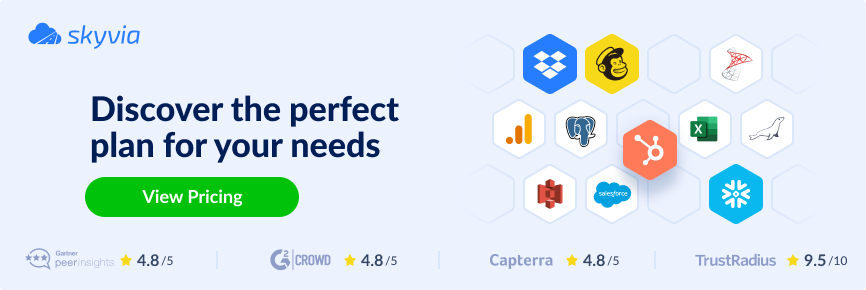In the company’s daily running, the top management is forced to spend significant efforts on obtaining unambiguous, accurate, and objective information about the state of affairs.
The business defines the conditions for which analysts collect and transform data to create a single point of truth to rely on when managing the organization.
One of the main questions that has become of interest to businesses recently is strategy and forecasting, like finance, sales, production, logistics, etc.
Companies are developing. The value of analytics is becoming more apparent. Businesses are no longer satisfied with performance indicators for building effective strategies and forecasts.
The common practice of data management and analytics improvement strategy is to use Salesforce and Oracle integration solutions for CRM and ERP processes.
Let’s review the connection methods provided, their benefits, and business cases to select the most suitable one for your needs.
Table of Contents
- Benefits of Salesforce and Oracle Connection
- Methods Overview: How to Integrate Salesforce with Oracle
- Method 1: Using APIs for Salesforce Oracle Integration
- Method 2: Oracle Integration Cloud with Prebuilt Salesforce Adapter
- Method 3: Using Salesforce Connect and Skyvia Connect
- Method 4: Using Middleware & ETL Tools
- Best Practices for a Successful Integration
- Conclusion
Benefits of Salesforce and Oracle Connection
So, why does your business need to use the Salesforce and Oracle connect options? What benefits may you obtain here, depending on the user scenarios? Let’s review the examples of dependencies in the table below.
| Scenarios | Benefits |
|---|---|
| Data Warehousing | – Establish a single source of truth in a centralized DWH. – Enable advanced analytics, BI, and machine learning workflows. – Support Reverse ETL to push insights back into operational tools (e.g., Salesforce, marketing platforms). – Store historical data for compliance and trend forecasting. |
| Data Synchronization | – Maintain a single source of truth within Salesforce or any operational system without routing through DWH. – Enable real-time or scheduled updates between systems. – Automate business processes by syncing key objects (e.g., contacts, leads, orders). – Ensure data consistency across departments and tools. |
| Data Connectivity / Integration Hub (e.g., via OData or Webhooks) | – Seamlessly connect multiple systems (e.g., CRMs, ERPs, marketing platforms, custom apps) for cross-functional data usage. – Suitable for AI/ML pipelines, especially in developer-heavy or integration-driven environments. – Build composite applications using data APIs, webhooks, and event-driven integrations. |
| Corporate Data Repository | – Build a well-governed, standardized, and accessible data store across the company. – Prepare data for enterprise analytics, compliance, and reporting. – Support of data stewardship and metadata management. |
Now, let’s go through the methods that provide Salesforce and Oracle connections using different services and tools.
Methods Overview: How to Integrate Salesforce with Oracle
Before diving into the detailed walkthroughs, let’s first look at the four main methods of such an integration. Each offers different capabilities in real-time synchronization, setup complexity, customization, and cost, so choosing the right one depends on a company’s business needs, technical resources, and long-term goals.
Let’s consider them briefly.
1. API-Based Integration (REST/SOAP)
A custom integration approach that uses Salesforce and Oracle APIs. Offers maximum flexibility but requires development expertise and ongoing maintenance. Best for companies with in-house developers and highly specific integration requirements. It allows companies to tailor every part of the data flow, business logic, and error handling. However, building and maintaining this kind of integration can be time-consuming and costly in the long run.
2. Oracle Integration Cloud (OIC)
Oracle’s native, low-code integration platform with pre-built connectors for Salesforce and other systems. Best for Oracle-centric organizations seeking a streamlined, supported solution. It offers visual flow builders, built-in monitoring, and tight integration with other Oracle products. While the solution simplifies setup, it may require additional licensing and could be more complex than needed for smaller-scale use cases.
3. Salesforce Connect
Allows Salesforce to access external Oracle data in real-time using OData or external objects without storing it in Salesforce. Best for companies that want real-time visibility without physically moving data between platforms. It’s ideal for reducing storage costs and avoiding data duplication, especially when only viewing data is required. However, external objects have limitations, like restricted support for automation, reporting, and specific UI customizations in Salesforce.
4. Middleware & ETL Tools (MuleSoft, Skyvia, Informatica, Boomi, etc.)
This method uses third-party platforms to build flexible, reusable, automated integrations. It often comes with prebuilt templates, scheduling, and transformation tools. Best for businesses looking for scalable, no-code, or low-code integration options with broader connectivity. These tools reduce development time and support a wide range of data sources beyond just Salesforce and Oracle. However, pricing and complexity vary between platforms, and some may require technical setup depending on the level of customization needed.
The table below displays the differences between these approaches based on real-time sync, ease of setup, customization level, and cost.
| Method | Best For | Real-Time Sync | Ease of Setup | Customization Level | Cost |
|---|---|---|---|---|---|
| 1. APIs (REST/SOAP). | Tech-savvy teams needing full control and custom logic. | Possible. | Complex (Developer. | Max. | Low (but high dev time). |
| 2. Oracle Integration Cloud (OIC). | Oracle customers seeking pre-built, supported integration. | Yes. | Medium. | Limited. | License required. |
| 3. Salesforce Connect. | Viewing Oracle data in real time without storing it in SFDC. | Real-time View. | Medium. | Minimal. | OData + SF license. |
| 4. Middleware / ETL (Skyvia, Boomi…). | Businesses needing scalable, no-code/low-code integration. | Yes (Middleware)/No ETL- Batch Processing. | Easy to Medium. | High. | Varies by vendor. |
Method 1: Using APIs for Salesforce Oracle Integration
This approach provides maximum control and flexibility. So, businesses can design highly customized, real-time data flows tailored to specific workflows. It involves directly calling Oracle APIs from Salesforce (or vice versa) using REST or SOAP protocols, allowing precise data handling, authentication, error logic, and more.
Unlike no-code or pre-built tools, API-based integration requires developer resources, API documentation knowledge, and ongoing monitoring and maintenance. However, it offers unmatched granularity and performance tuning for complex use cases.
Key Features
Salesforce APIs
- REST API. Lightweight and easy to use, great for real-time data exchange and mobile/web integrations.
- SOAP API. Offers robust data handling and is better suited for complex data structures.
- Bulk API / Bulk API 2.0. Ideal for high-volume data transfers.
- Streaming API. For event-based messaging, e.g., syncing changes as they happen.
Oracle APIs
- Oracle REST Data Services (ORDS). RESTful interface to Oracle databases, widely used for exposing Oracle data via HTTP.
- SOAP Web Services (e.g., Oracle E-Business Suite). Enterprise-grade operations using WSDL-based services.
- Oracle Fusion Cloud APIs. Modern REST/SOAP endpoints are available for Oracle ERP, HCM, etc.
- GraphQL APIs. Supported in some newer Oracle services for flexible data querying.
Best For
Businesses needing a fully customized integration with developer expertise, especially those with: complex business logic, highly specific transformation or validation rules, security/compliance requirements that pre-built tools can’t support.
Use Cases
- Syncing custom Salesforce objects with Oracle ERP modules (e.g., Orders, Inventory).
- Pushing real-time transaction data from Salesforce to Oracle for fulfillment and billing.
- Creating a custom data sync scheduler or retry mechanism for high-reliability integrations.
- Supporting hybrid integration needs, such as connecting Salesforce, Oracle, and a legacy on-prem system.
Cost
High upfront and ongoing costs due to:
- Developer time for integration logic and testing.
- API management (authentication, throttling, monitoring).
- Maintenance, debugging, and versioning as systems evolve.
- Integration tools do not charge licensing fees, but their total cost of ownership (TCO) can exceed that of middleware or low-code platforms.
Pros
- Maximum flexibility and control over data flow, transformation, and logic.
- Real-time or near-real-time data sync capabilities.
- No dependency on third-party integration tools.
- Ideal for complex and custom business logic scenarios.
- It can be highly optimized for performance.
Cons
- Requires significant development effort and expertise.
- High ongoing maintenance and support burden.
- Error handling, retry logic, and monitoring must be built from scratch.
- Tight coupling to API versions can introduce upgrade risk.
- Not suitable for non-technical teams or quick deployments.
Method 2: Oracle Integration Cloud with Prebuilt Salesforce Adapter
OIC is a low-code integration platform that offers a prebuilt Salesforce adapter, allowing users to connect Oracle apps with Salesforce without extensive coding. It provides a visual interface, reusable templates, and out-of-the-box connectors to manage system data flows and events.
The system supports real-time and scheduled integration and can orchestrate complex workflows involving Salesforce, Oracle ERP/HCM, and other third-party applications.
Key Features
- Drag-and-drop workflow automation for building integrations without coding.
- Pre-configured Salesforce & Oracle connectors to accelerate setup.
- Supports APIs, batch, and event-driven integrations for flexible use cases.
- AI-powered data mapping to simplify field matching and reduce manual work.
- Built-in monitoring and error tracking for visibility and issue resolution.
- Secure connectivity with role-based access control and audit logging.
- Support for hybrid cloud and on-premises environments.
- Extensive library of integration templates to streamline common workflows.
- Seamless integration with Oracle SaaS applications (ERP, HCM, SCM, etc.)
Best For
Organizations that are already Oracle customers and want to integrate with Salesforce quickly using supported, enterprise-grade tools without building everything from scratch.
Use Cases
- Syncing Salesforce leads and opportunities with Oracle ERP sales orders or quotes.
- Sending Oracle HCM employee records into Salesforce for onboarding workflows.
- Connecting Oracle Financials with Salesforce to reflect payment and invoice statuses.
- Creating bi-directional sync between Salesforce and Oracle SCM for order tracking.
Cost
- License-based pricing tied to Oracle Cloud usage.
- It may be bundled for existing Oracle SaaS customers.
- Cost varies depending on the number of connections, transactions, and required services.
Pros
- Easy bi-directional integration with Salesforce.
- Easy mapping to and from Salesforce business objects.
Cons
- The pricing is high enough (about $4000 per month).
- The number of created external objects is limited (100).
- The number of connections between external and other entities per request limitation (4).
- The number of OAuth tokens by an external system limitation (4000 characters).
- The total page size for server-managed paging limitation (2000 lines).
Click here for more details on how to connect to apps to share data.
The limitations and unfriendly pricing of such a semi-native tool make data exchange entirely on the Skyvia platform a more profitable solution.
Method 3: Using Salesforce Connect and Skyvia Connect
This approach allows Salesforce to access data stored in Oracle in real-time without importing it into Salesforce. It uses external objects to represent Oracle data as native to Salesforce. Combined with Skyvia Connect, which exposes Oracle data as OData endpoints, it becomes a powerful solution for viewing and interacting with Oracle insights live from Salesforce. This method is a miraculous choice for organizations that need real-time access to Oracle data in Salesforce but want to avoid data duplication and storage costs.
Key Features
- With it, you may connect data from the Oracle database with Salesforce without programming, using a combination of OData connection for Oracle and native Salesforce Connect.
- The method supports OData 2.0 and 4.0 protocols or custom adapters, depending on the Oracle setup.
- OData allows users to create an OData endpoint for an Oracle database that will be exposed as an external object in Salesforce using Salesforce Connect.
- External objects in Salesforce can mirror the Oracle data structure.
- Users may read/write access (depending on the Salesforce edition and setup).
- You don’t need to schedule syncs or manage data replication.
Best For
Organizations that:
- Need up-to-date Oracle data in Salesforce without importing or duplicating it.
- Want to reduce Salesforce storage usage and costs.
- Require real-time visibility, not batch updates.
Use Cases
- Viewing Oracle customer or order records in Salesforce accounts without syncing data.
- Allowing support reps to check Oracle case statuses in real time from within Salesforce.
- Displaying Oracle ERP or HR data in Salesforce dashboards and reports using external objects.
- Creating a unified 360-degree view of customers by merging Oracle and Salesforce data in the UI.
Cost
- Salesforce Connect license is required for using external objects (included in some editions, paid add-on in others).
Pros
- OData provides real-time data export from legacy systems such as SAP, Microsoft, etc.
- There is no duplication, and data stays in Oracle, reducing storage use in Salesforce.
- Enables real-time access to Oracle records directly within Salesforce.
- Simplifies integration with no sync schedules or data maintenance.
- Fast setup with Skyvia Connect (no code required).
- Great for read-heavy use cases and dashboards.
Cons
- OData isn’t as fast as REST because REST works directly over HTTP/HTTPS, and OData is an extension of HTTP/HTTPS.
- Salesforce Connect requires additional licensing (depending on the edition).
- External objects are limited in functionality compared to native ones (e.g., no triggers, workflows).
- Performance depends on Oracle’s availability and response time.
- Write-back operations may be limited or require extra configuration.
Click here for detailed instructions on connecting Salesforce with external data systems via OData adapters.
OData 2.0 vs. OData 4.0
Let’s compare these two popular solutions to see which suits your business scenario best.
| Parameter | OData 2.0 | OData 4.0 |
|---|---|---|
| Methods for entities update | MERGE HTTP method | HTTP PATCH method with Edit semantics |
| Supported formats | XML and JSON | JSON by default, but the metadata may be retrieved in the XML format |
| Certifications | OSP | ISO, OASIS |
| Amount metadata control of query response for JSON | – | – Full – Minimal – None |
| Batch requests support | – | + |
| Search abilities | Search filter (allows a query to specify that the selected properties match some appropriate criteria) | Search (can search by any entity property) |
Please go here to review the most helpful scenarios of using Skyvia for Salesforce and Oracle data integration.
Method 4: Using Middleware & ETL Tools
Middleware platforms and ETL tools like Skyvia, MuleSoft, Informatica, Boomi, etc., offer flexible, scalable, and low-code/no-code options for integrating Salesforce and Oracle. These tools act as intermediaries between the systems, enabling users to extract, transform, and load (ETL) data or synchronize it in real-time or on a schedule.
They support a wide range of integration patterns, like batch ETL, real-time sync, reverse ETL, and even complex data orchestration involving multiple systems.
Key Features
- Prebuilt connectors for Salesforce, Oracle, and hundreds of other platforms.
- Drag-and-drop interfaces for building data pipelines.
- Advanced transformation capabilities, including data mapping, filtering, enrichment, and lookups.
- Scheduling and automation of recurring data syncs.
- Support multiple integration types: ETL, ELT, reverse ETL, sync, and replication.
- Monitoring, logging, and alerting dashboards.
Best For
- Organizations that require scalable and reusable integrations.
- Teams seeking automated data movement without heavy development effort.
- Businesses working with multiple data systems, not just Salesforce and Oracle.
Use Cases
- Extracting Oracle ERP sales data and loading it into Salesforce for account visibility.
- Syncing Salesforce opportunities with Oracle order processing systems.
- Running scheduled data loads from Salesforce to Oracle for financial reconciliation.
- Moving product catalogs from Oracle into Salesforce for sales enablement.
- Integrating Salesforce, Oracle, and marketing tools into a unified data warehouse.
Cost
- Pricing varies depending on platform and usage.
- Skyvia offers a free plan and affordable paid tiers.
- Enterprise platforms like MuleSoft or Informatica may require larger investments.
- Cost is typically based on data volume, number of connectors, and advanced features used.
Pros
- No-code or low-code setup with intuitive UI.
- Such solutions support complex workflows with multiple data sources and destinations.
- They reduce manual tasks and human error through automation.
- Tools like Skyvia include logging, monitoring, and rollback options.
- Easy to scale across departments and systems.
Cons
- This method may require platform-specific learning curves.
- Real-time sync depends on tool capabilities (some are better for batch).
- Costs may increase with the volume of data, connectors, or premium features.
- Limited control compared to fully custom API-based integrations.
Skyvia is a great tool for ETL, ELT, and reverse ETL. And, of course, it offers an ETL approach for Salesforce and Oracle connection among its 200+ connectors
Let’s review two real-life use cases showing how it works.
Case 1: Integrate Oracle to Salesforce (Step-by-Step Guide)
Imagine that company leads decided that even passive sales via the Internet must be under management control.
In this case, for CRM Salesforce Source of Truth, there will be packages of import, e.g., “Create Salesforce records (Contacts, Opportunity, Product) from rows in Oracle Table.”
Let’s go down the steps on how to do it:
- Go to the top menu and click + Create New.
- Select Import in the Integration column.
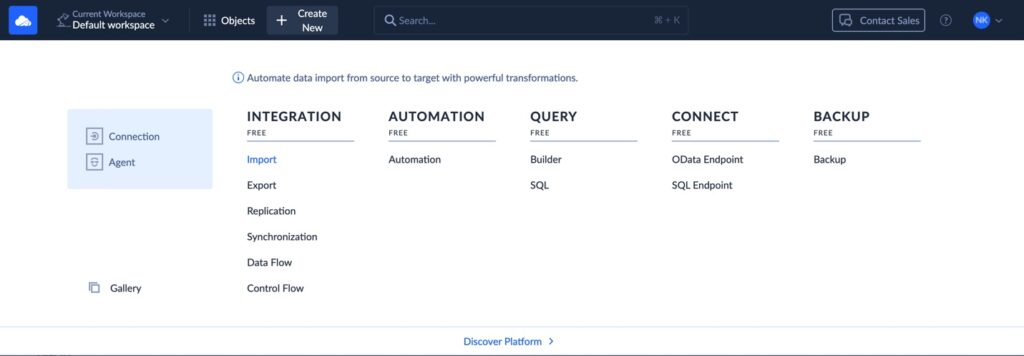
- Select the Source Type (databases or cloud apps), Connection (Oracle), and Target (Salesforce) appropriately.
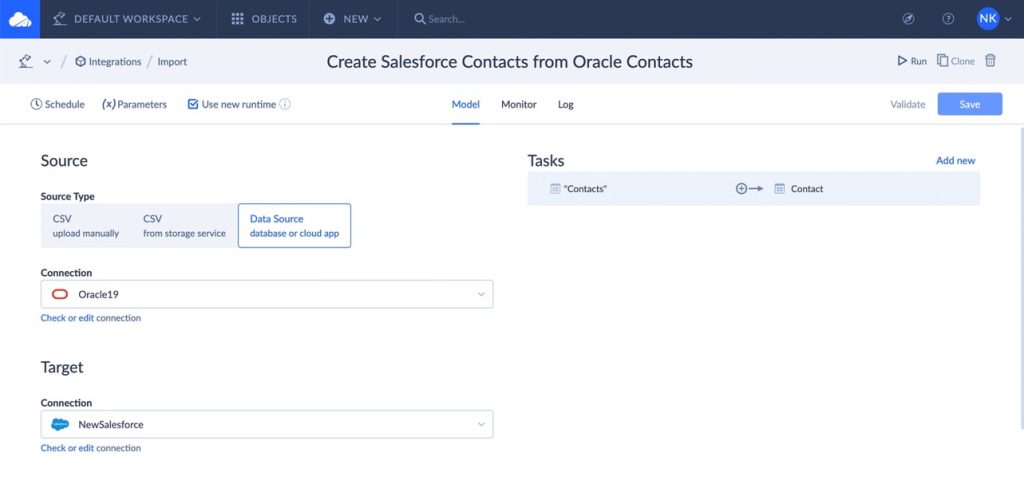
- Go to the Task Editor, click Add New, and select the necessary tables like Contacts in the Source drop-down list. (Note: You may add the specific conditions here by clicking +Condition).
- On the next step, select Contacts in the Target drop-down.
- Go to the Mapping Definition tab and configure the mapped columns.
- Set up the package’s schedule and click the Save button.
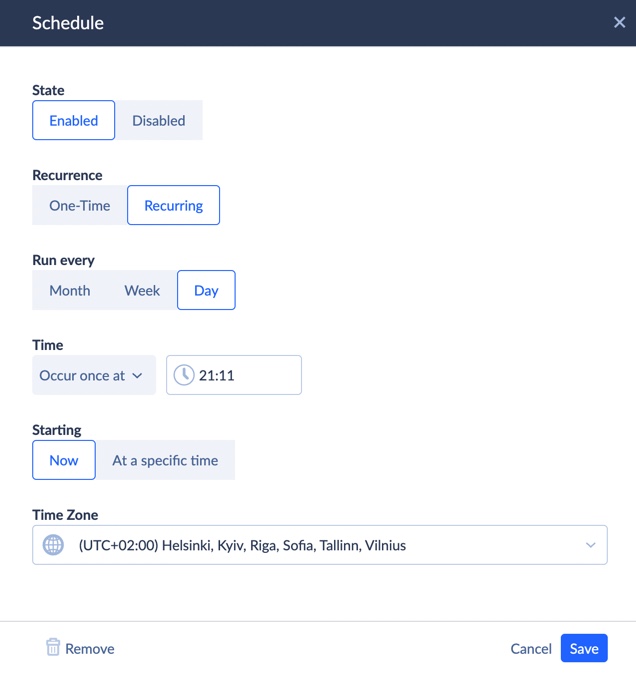
The same scenario works with Oracle’s single source of truth. You just have to change the source and target name. And, of course, you may use Data Flow or Control Flow features to create and manage multi-stage data pipelines for more complex integration.
Case 2: Replicate Salesforce to Oracle (Step-by-Step Guide)
Mostly, this is the replication of all systems in a single repository. Replicate Salesforce tables (Contacts, Opportunity, Product) to the data warehouse and keep it up to date automatically.
How to do it:
- Start with the top menu by clicking +Create New.
- Select Replication in the Integration column.

- Choose the Connection (New Salesforce) and Target (BQCon) in the Source Type fields.
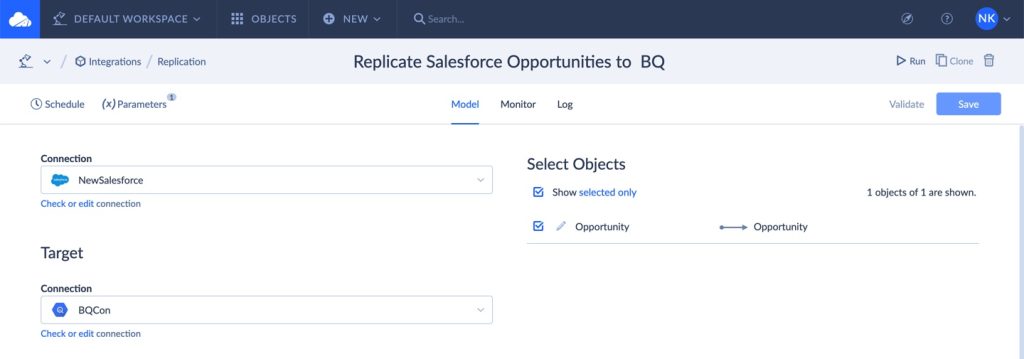
- Check the necessary Options from the list below:
- Incremental updates.
- Update Schema.
- Create Tables.
- Drop Tables.
- Create Foreign Keys.
Note: In this case, you need the ones checked on the screenshot.
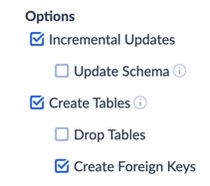
- Choose the replication objects and click Run and Save to finish the process.
Note: You may use the Schedule option for the automated replication procedure, as described in the Contacts Import scenario. You have to use the Import package to load Oracle data into DWH.
Best Practices for a Successful Integration
- Define clear objectives. Identify what data needs to be integrated, why, and how it will support your business processes.
- Choose the right integration method. Consider real-time needs, data volume, team skills, and system complexity when selecting between API, middleware, OData, or prebuilt tools.
- Establish strong data mapping and transformation rules. Ensure consistency between systems by aligning field formats, data types, and business logic early in the process.
- Implement error handling and monitoring. Set up logs, alerts, and retry mechanisms to detect and respond to issues proactively.
- Use a sandbox for testing. Always test integration flows in a non-production environment to prevent disruptions and validate functionality.
- Plan for long-term maintenance. Monitor for API changes, schema updates, and shifting business requirements to keep the integration reliable over time.
Conclusion
If you compare the methods and solutions, each is fine for solving the daily routine and some usual tasks depending on your business needs. However, while selecting the most valuable scenarios, Skyvia is a bit ahead with its capabilities, meaning simplicity, intuitive UI, and keeping the offering and pricing in balance.
In any case, these integration methods automate workflows, maintain data consistency, and gain a unified view across systems. Whether you need real-time access, custom data transformation, or secure connectivity, selecting the right approach will directly impact the team’s productivity and data strategy. Focus on scalability, maintainability, and alignment with your infrastructure to ensure long-term integration success.
FAQ for Salesforce Integration with Oracle
Can I get real-time data from Oracle and put it into Salesforce?
Yes, real-time data access is possible using Salesforce Connect with Skyvia Connect. This method lets Salesforce display live Oracle data using external objects without storing it inside Salesforce.
What’s the difference between ETL and Salesforce Connect?
ETL transfers and transforms data physically between systems, often on a schedule. Salesforce Connect uses OData and external objects to access Oracle data in real-time without moving it.
Is Oracle Integration Cloud the best option if I already use Oracle ERP or HCM?
Yes, Oracle Integration Cloud (OIC) is optimized for Oracle’s ecosystem and includes a prebuilt Salesforce adapter, making it a strong low-code solution for Oracle-centric companies.
How do I know which method to choose?
Choose based on your priorities:
– Use APIs for full control and customization.
– Use OIC for fast Oracle-native integration.
– Use Skyvia/Middleware for flexible, no-code automation.
– Use Salesforce Connect for real-time data visibility without data replication.
Does Salesforce Connect require an extra license?
Yes, Salesforce Connect is not available in all editions and may require a separate license, depending on your Salesforce plan.

